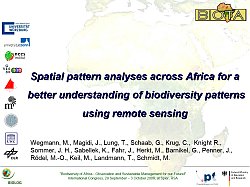|
|
|
 |
|
|
Presentation
< back to presentation overview
| Details of the presentation |
| Presentation |
Oral presentation |
| Title |
Spatial pattern analysis across Africa for a better understanding of biodiversity patterns using remote sensing.
|
| PDF Download |
 Download PDF (Filesize 3.4 MB)
Download PDF (Filesize 3.4 MB)

|
| Short title |
Spatial pattern analysis using remote sensing.
|
| Author(s) |
Wegmann, M.(1); Magidi, J.(2); Lung, T.(3); Schaab, G.(3); Krug, C.(7); Knight, J.(2); Sommer, J.H.(4); Sabellek, K.(4); Fahr, J.(5); Herkt, M.(5); Barnikel, G.(5); Penner, J.(6); Rödel, M.-O.(6); Keil, M.(8); Landmann, T.(1); Schmidt, M.(8)
|
| Presenting author |
Wegmann, M. (1)
|
| Institution(s) |
(1) Remote Sensing Department in cooperation with DLR, University of Wuerzburg, D-97074 Würzburg, Germany; (2) University of the Western Cape, Cape Town, South Africa; (3) Institute of Applied Research, Karlsruhe University of Applied Sciences; (4) Nees Institute for Biodiversity of Plants, Rheinische Friedrich-Wilhelms-Universität, D- 53115 Bonn, Germany; (5) Institute f. Experimental Ecology - Biology III, University of Ulm, D- 89069 Ulm, Germany; (6) Museum für Naturkunde der Humboldt Universität zu Berlin, D- 10115 Berlin, Germany; (7) University of Cape Town, Cape Town, South Africa; (8) German Remote Sensing Data Centre (DFD), German Aerospace Centre (DLR), Oberpfaffenhofen, Germany
|
| Keywords |
Fragmentation; spatial pattern analysis; biodiversity; MODIS time-series; remote sensing
|
| Abstract |
Habitat fragmentation is a major concern of ecologists and conservationists. Using remote sensing data to identify habitat types and their level of fragmentation supports large scale biodiversity assessments.
In BIOTA Africa we mapped land fragmentation using contemporary and large scale land cover data. Field derived habitat observations were related to spatially explicit remote sensing observations on land cover to map fragmentation on a local scale in East Africa, and a large scale in West Africa. In Southern Africa fragmentation was inferred from satellite time series to assess the impact of farming activities on natural habitats.
Results from all three BIOTA areas show the utility of satellite remote sensing data sets, augmented with field observations, to accurately infer past and present patterns of land fragmentation. Hence through the synergetic effects of remote sensing data and spatial pattern analysis it is feasible to delineate areas of high importance for the persistence of populations in a landscape.
As part of an application tool we envisage that this knowledge will help BIOTA project stakeholders and partners to visually explore fragmentation scenarios under a variety of local and large scale biodiversity management options.
|
| Congress Topic |
Observation System
|
| Topic No. |
1.2 |
| Notes |
---
|
| Ref. No. |
553 |
|
|
|
